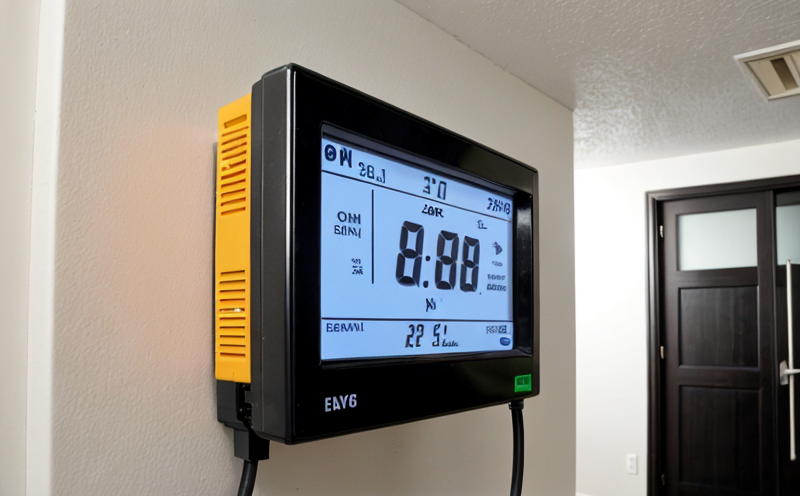EN 14511 Performance Testing of Air Conditioners
The European standard EN 14511:2006 specifies the procedure for determining the energy efficiency and performance characteristics of air conditioners. This testing is crucial for manufacturers, quality managers, compliance officers, and R&D engineers to ensure that their products meet or exceed the stringent requirements set by this standard.
EN 14511 primarily focuses on the measurement of cooling capacity, heating capacity, seasonal energy efficiency ratio (SEER), and annual energy usage (AEU) under defined conditions. The testing process involves placing an air conditioner in a climate chamber that simulates real-world operating environments. This ensures that the performance metrics obtained are representative of actual use.
The standard is applicable to both residential and commercial units, including window ACs, split systems, ducted systems, and multi-zone units. It covers not only the performance characteristics but also the energy consumption under various operational conditions such as full load, part load, and typical daily operating conditions.
Manufacturers often use this standard to demonstrate compliance with local and international regulations, which can be a significant factor in marketing their products to consumers who are increasingly aware of environmental impact. For R&D engineers, EN 14511 provides a clear roadmap for optimizing product design and improving energy efficiency.
The testing procedure involves several steps, each critical for obtaining accurate results:
- Setup: The air conditioner is installed in the climate chamber with appropriate connections to supply power, water, and refrigerant (if applicable).
- Calibration: All instruments used for measurement are calibrated according to standard procedures.
- Measurement: Various parameters such as outlet temperature, indoor and outdoor temperatures, humidity levels, and energy consumption are measured under controlled conditions.
- Data Analysis: The collected data is analyzed using the formulas provided in EN 14511 to calculate SEER and AEU values.
The results of this testing are critical for manufacturers as they provide a clear picture of how their products perform under real-world conditions. This information can be used to make informed decisions about product design, marketing strategies, and compliance with regulatory requirements.
| Parameter | Description | Test Condition |
|---|---|---|
| Cooling Capacity | The amount of heat that can be removed from the space in a given time period at standard conditions. | Outdoor temperature 35°C, indoor temperature 29.4°C, relative humidity 60%. |
| Heating Capacity | The amount of heat supplied to the space in a given time period under specified heating conditions. | Outdoor temperature -17.8°C, indoor temperature 15°C, relative humidity 43%. |
| SEER (Seasonal Energy Efficiency Ratio) | A measure of the cooling efficiency over an entire season rather than just peak performance. | Based on a weighted average of full load and part load conditions. |
| AEU (Annual Energy Usage) | The total energy consumed by the air conditioner during a typical year's operation. | Average of multiple test runs under varying environmental conditions. |
In summary, EN 14511 is an essential standard for the testing and certification of air conditioners. It provides manufacturers with a comprehensive framework for evaluating their products' energy efficiency and performance characteristics. Compliance with this standard can significantly enhance a company's reputation in the market and ensure that its products meet or exceed regulatory requirements.
Applied Standards
The European standard EN 14511:2006 is widely recognized for its comprehensive approach to testing air conditioners. This standard ensures that the performance and energy efficiency of air conditioning units are accurately measured under controlled conditions.
| Standard | Description | Key Requirements |
|---|---|---|
| EN 14511:2006 | Performance testing of air conditioners. | - Measurement of cooling and heating capacity. - Calculation of SEER and AEU values. - Compliance with international regulations. |
The standard is regularly updated to reflect the latest technological advancements and regulatory requirements. Manufacturers are advised to stay informed about these updates to ensure their products remain compliant with current standards.
Scope and Methodology
The scope of EN 14511 includes the performance testing of air conditioners for both residential and commercial applications. The methodology involves several key steps:
- Setup: Installation of the air conditioner in a climate chamber.
- Calibration: Calibration of all measurement instruments to ensure accuracy.
- Measurement: Recording of various parameters such as outlet temperature, indoor and outdoor temperatures, humidity levels, and energy consumption.
- Data Analysis: Calculation of SEER and AEU values based on the collected data.
The climate chamber simulates real-world operating conditions to provide accurate performance metrics. This ensures that the testing results are representative of actual use in different environments. The standard also provides guidelines for reporting the test results, which can be used by manufacturers to demonstrate compliance with regulatory requirements.
Benefits
- Compliance: Ensures that air conditioners meet or exceed local and international regulations.
- Marketing Advantage: Demonstrates to consumers the energy efficiency of products, which can enhance brand reputation.
- Informed Decision-Making: Provides R&D engineers with a clear framework for optimizing product design and improving performance.
- Quality Assurance: Ensures that air conditioners perform consistently across different environments and conditions.
- Cost-Effective: Identifies areas for improvement in product design to reduce energy consumption without compromising performance.
The benefits of EN 14511 are numerous, ranging from compliance with regulatory requirements to enhanced marketing advantages. By ensuring that air conditioners perform consistently and efficiently under various conditions, this standard plays a crucial role in the industry.





